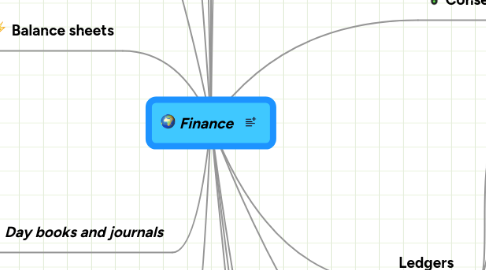
1. Balance sheets
1.1. The record of a company's value at a point in time
1.2. Assets
1.2.1. Fixed
1.2.1.1. Premises
1.2.1.2. Machinery
1.2.2. Current
1.2.2.1. Cash
1.2.3. something the business owns
1.3. Liabilities
1.3.1. Long term
1.3.1.1. Loans
1.3.2. Current
1.3.2.1. Creditors
1.3.3. something the business owes
1.4. IT MUST BALANCE
2. Day books and journals
2.1. Sales day book / journal
2.1.1. Credit sales
2.2. Purchases day book / journal
2.2.1. Credit purchases
2.3. Sales returns day book / returns in journal
2.3.1. Credit notes issued
2.3.1.1. Goods returned by customers to us
2.4. Purchases returns day book / returns out journal
2.4.1. Credit notes received
2.4.1.1. Good returned by us to suppliers
2.5. The journal (proper)
2.5.1. Less common and complicated items
2.5.1.1. One off purchases
2.6. Cash book
2.6.1. bank account
2.6.2. cash account
3. Double entry
3.1. Used by ledgers - NOT BOOKS (except cash book)
3.2. Every financial action has two effects
3.2.1. Good
3.2.1.1. DEBIT SIDE
3.2.1.1.1. new asset
3.2.2. Bad
3.2.2.1. CREDIT SIDE
3.2.2.1.1. £20,000 cost
4. Depreciation
4.1. Reduction in value of a fixed asset
4.2. Shows "book value"
4.2.1. representation of how much use the asset has left for business
4.3. Value decreases due to
4.3.1. Wear and tear
4.3.2. Decay
4.3.3. Depletion
4.3.4. Obsolescence (technology e.g. VCR's today)
4.3.5. Inadequacy
4.4. Straight line
4.4.1. Reduce value of asset by same each year
4.4.1.1. Cost of asset - expected selling value / useful life (years)
4.4.2. BUT
4.4.2.1. doesn't account for problems with a machine e.g. renew parts
4.4.2.2. unrealistic
4.4.2.2.1. items don't decrease by same amount each year
5. Stakeholders interested in financial info (& why)
5.1. Creditors
5.2. Owners
5.3. Managers
5.3.1. performance of company
5.3.2. internal analysis
5.4. Customers / pressure group
5.5. Government
5.5.1. See how much a company owes accurately
5.6. Competitors
5.6.1. judge company's success
5.6.2. market share
5.7. Banks and lenders
5.7.1. See / gauge a company's ability to pay back money
5.8. Shareholders
5.8.1. Dividends
5.8.2. Consider investment
5.9. Investors
5.9.1. Safe investment?
5.9.2. Good return?
6. Prepayments
6.1. Items paid for but not yet used
6.1.1. e.g. Insurance
6.2. DO NOT affect profits but will next financial period
6.3. increase profit declared
6.3.1. deducted from expenses
6.4. added to current assets of BL
6.4.1. increase working capital
6.5. MINUS prepayments
7. Why monitor accounts?
7.1. Operate legally
7.2. Keep track of business accurately e.g. profit and loss
7.3. Identify where they are losing and gaining money from
7.4. Identify deliberate and accidental accounting
7.5. Track of creditors and debtors
7.6. Stakeholders want accurate reports
7.6.1. build confidence
7.7. Prepare for cash flow forecasts and final accounts
7.8. Info for budgetting
8. Ledgers
8.1. Sales
8.1.1. Accounts of customers that have bought goods on credit
8.1.1.1. Invoices issued
8.1.1.2. Credit notes issued
8.1.1.3. Payments recieved
8.2. Purchase
8.2.1. Accounts of suppliers whom the business has boguht goods on credit
8.2.1.1. Invoices received
8.2.1.2. Credit notes received
8.2.1.3. Payments sent
8.3. General
8.3.1. Most other accounts
8.3.1.1. Fixed assets
8.3.1.2. Expenses
8.3.1.3. Income
8.4. Cash book
8.4.1. cash account
8.4.1.1. cash held by business
8.4.2. business account
8.4.2.1. payments in and out of the bank account
9. Consequences
9.1. Fines for wrong information
9.1.1. Company's house
9.2. Business losses track of itself
9.2.1. Time and money spent on redoing accounts or putting procedures in place
9.2.2. Unable to assess itself successfully
9.3. Legal implications
9.3.1. Fraud
9.4. Wrong amount paid for tax
9.5. Lack of confidence
9.5.1. stakeholders
9.6. Creditors not paid
9.7. Poor management decisions
10. Profit and loss statement
10.1. a record of revenues and costs of the business over a period e.g. year
10.2. Three parts
10.2.1. Trading account
10.2.1.1. Cost of goods sold (sales) taken away from revenue (to make gross profit)
10.2.1.2. Cost of sales = (opening stock + purchases) – closing stock
10.2.2. Profit and loss account
10.2.2.1. indirect costs (overheads) taken away from gross profit
10.2.2.2. create net or operating profit
10.2.3. Appropriation account
10.2.3.1. How money is split up between
10.2.3.1.1. Corporation tax
10.2.3.1.2. Dividends
10.2.3.1.3. Reinvestment
10.3. measures amount of money a company makes or loses over a period
10.3.1. revenue is what the company earns through sale of goods or services
10.3.2. costs are something a company pays out when producing goods or services
11. Trial balance
11.1. checking system
11.2. all debit should equal credit
11.3. if it doesn't balance there are errors
11.4. a trial balancing might still have a error
12. Errors
12.1. Commision
12.1.1. Wrong name of supplier or customer
12.2. Omission
12.2.1. Transaction has occured BUT
12.2.2. no record has been made in accounts
12.3. Principle
12.3.1. transaction classified incorrectly
12.4. Compensating error
12.4.1. Coincidence
12.4.2. A number of mistakes that happen to cancel each other out
12.5. Original entry
12.5.1. original figure is incorrect
12.6. Reversal
12.6.1. entries on wrong side of account
13. Accruals
13.1. When item has been used but not yet paid for
13.2. Not recorded
13.2.1. No transaction has taken place yet
13.2.1.1. e.g. Jobs pay in arrears
13.2.1.1.1. Work for a period of time
13.2.1.1.2. THEN paid
13.3. decrease profit a business declares
13.4. amounts owing added to PL expenses
13.5. current liabilitiy in BL
13.5.1. reduces working capital
13.6. ADD ACCRUALS
14. Corrections
14.1. Most errors found at later date
14.2. When discovered, original accounts cannot be altered
14.3. Corrections are made using double entry system. The journal is used as there are no source documents ot prove transaction has occured
14.3.1. A narrative can be written to explain the error and actions taken
